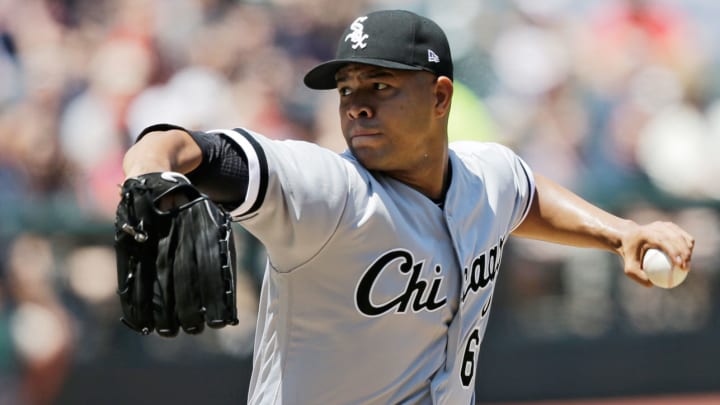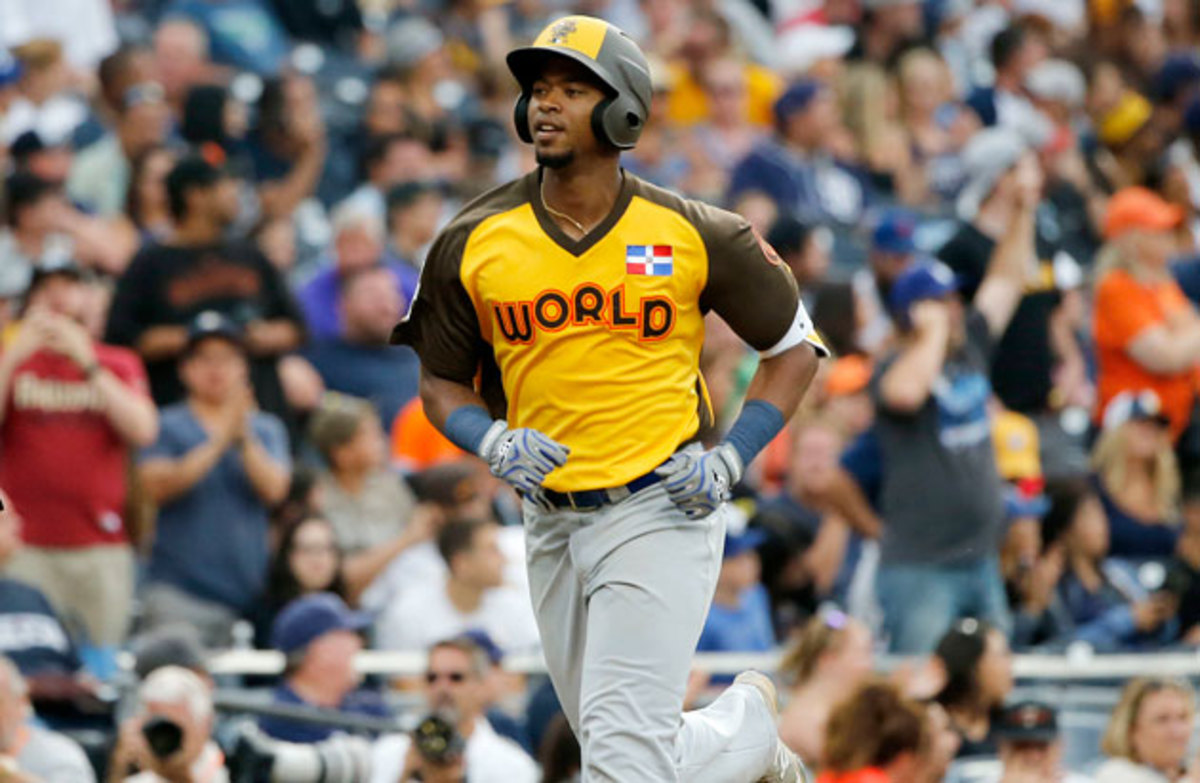Jose Quintana trade is a savvy move for the Cubs and their struggling pitching staff

For the first time since 2006, the Cubs and White Sox have swung a deal. Desperate to patch up their battered rotation, the defending world champions have sent a four-prospect package headlined by outfielder Eloy Jimenez, recently anointed the game's fifth-best prospect by Baseball America, to the South Side for lefty Jose Quintana, who has underperformed this year but has three very affordable years of club control remaining.
On the heels of their first World Series win since 1908, the Cubs have experienced a greater championship hangover than most. They entered the All-Star Break at 43–45, having lost eight of their last 12, and sit 5 ½ games behind the Brewers in the NL Central.
While the regressions of their offense and defense are to blame as well, their rotation's slide from last year's MLB-best 2.96 ERA to this year's 4.66 mark (eighth in the league, accompanied by a 4.50 FIP) has been particularly noticeable lately. Cubs starters managed just two quality starts in their last eight turns and were bombed for a 6.82 ERA. In their first half finale, Jon Lester, last year's runner-up in both the NL Cy Young voting and the ERA race, was torched for 10 runs (four earned) in two-thirds of an inning. Kyle Hendricks and fifth starter Eddie Butler are the only members of the rotation with an ERA+ of at least 100, but Hendricks, who led the league with a 2.16 mark last year, has seen his ERA nearly double to 4.09. He just began a rehab assignment after missing the past month due to tendinitis in his right hand. John Lackey landed on the DL last week due to plantar fasciitis, which he had been pitching through, but the bigger problem has been his astronomical home run rate of 2.2 per nine, swelling his ERA and FIP to 5.20 and 5.66, respectively.
The 28-year-old Quintana made his first All-Star team last year while setting career bests in ERA (3.20), ERA+ (126), innings (208) and strikeouts (181). That was his fourth straight season reaching 200 innings with an ERA of 3.51 or better and at least 164 strikeouts. Among all major league starters with at least 600 innings from 2013-16, his 18.1 WAR ranks seventh behind Clayton Kershaw, Max Scherzer, former teammate Chris Sale, Cole Hamels, Zack Greinke and Corey Kluber, with his 814 2/3 innings 12th and his 118 ERA+ (3.35 ERA) 16th. But Quintana has been erratic this season, with career worsts in home run and walk rates (1.2 and 3.5 per nine, respectively) offsetting a career best strikeout rate of 9.4 per nine. He's managed a quality start just 50% of the time after doing so in 72% of his starts last year and 78% the year before, and his monthly ERAs have been above 5.00 in every month except June, when he pitched to a minuscule 1.78 mark.
Quintana has pitched somewhat better than his peripherals indicate, as his 4.01 FIP suggests, and his rates of hard, medium and soft contact haven't moved more than a percentage point from last year. The Cubs are banking that a change of scenery to a more competitive team will help, and like the numerous other clubs who targeted him—first and foremost the Astros, who tried to acquire him over the winter, and more recently the Angels, Blue Jays, Cardinals, Orioles, Royals and Yankees, all of whom had scouts at his last start—were enticed by his club-friendly contract. Quintana signed a five-year, $21 million deal in 2014, one that guarantees him $7 million this year and $8.85 million next year, with club options for $10.5 million in both 2019 and '20.
Play ball (again)! Home run chases, pennant races, trading aces, new World Series faces
With Lackey and the underperforming Jake Arrieta (4.35 ERA, 4.17 FIP) both free agents at the end of this season, adding a pitcher who is a reasonable bet to provide 200 above-average innings a year for the next two seasons was enough for president of baseball operations Theo Epstein and general manager Jed Hoyer to bite the bullet and deal the team's two top prospects, Jimenez and righty Dylan Cease. Also in the deal are two players outside the team's MLB Pipeline top 30 prospects list, first baseman Matt Rose and infielder Bryant Flete. All but Cease, who was pitching for the team's Low A South Bend affiliate, were teammates at High A Myrtle Beach, which is to say that they're still at least a couple years from the majors.
The prize of the package is the 20-year-old Jimenez, a strapping 6' 4" Dominican corner outfielder whom the Cubs signed for a $2.8 million bonus in 2013. At pitcher-friendly Myrtle Beach, he was hitting .271/.351/.490 with eight homers in 42 games, that after missing the first six weeks of the season due to a bone bruise in his right shoulder. Jimenez tore up the A-level Midwest League last year as a 19-year-old (.329/.369/.532 with 14 homers), and came into the season ranked as high as ninth on the major prospect lists.

As noted back in February, Jimenez has drawn comparisons to Giancarlo Stanton based on his size, bat speed and plus-plus power. His hit tool is a plus, as he uses the whole field well and doesn't sell out for power. Notably, his walk rate has jumped from 6.7% last year to 10.3% this year. In the past few days, both Baseball America and ESPN placed him fifth on their midseason lists, with the former justifying his placement "largely because the hitters above him have more defensive value. Jimenez does not run well enough to be a center fielder or throw well enough to be a right fielder."
The 21-year-old Cease was drafted out of a Georgia high school by the Cubs in 2014; he slipped to the sixth round that year because he was recovering from Tommy John surgery but received a $1.5 million bonus, in line with a second-round pick. In his first taste of full season ball, he has dominated the Midwest League, posting a 2.79 ERA and allowing just two homers in 51 2/3 innings while striking out 12.9 per nine, though due to an ankle injury and an innings cap, he's been kept on a short leash, going five innings or more in just four of his 13 starts. Ranked 90th on BA's spring list (as high as 77th via MLB Pipeline), he was 83rd on their midseason one. His fastball sits 94–97 mph and can touch 100, his 12-to-6 power curve is a plus pitch as well, but his changeup and control both need improvement; without those, he could wind up a late-game reliever instead of a starter.
The 24-year-old Flete has generally been old for his level since signing out of Venezuela at age 19 in 2012. Playing more second base than shortstop and showing what BA called "a decent all-fields, line drive approach," he hit .305/.355/.425 with six homers at Myrtle Beach. The 22-year-old Rose was the team's 11th round 2015 pick out of Georgia State. Though he's demonstrated his plus-plus power via 14 homers in 65 games at Myrtle Beach, his .227/.281/481 line and 25% strikeout rate suggest he's got a whole lot of work to do, particularly given that his limited mobility has already pushed him from third base to first.
Even if Flete and Rose are just providing organizational depth, the additions of Jimenez and Cease give the White Sox seven of BA's top 100 midseason prospects thanks largely to the rebuilding-minded deals done by VP/G Rick Hahn:
Midseason Ranking | Spring Ranking | Player | Position |
|---|---|---|---|
1 | 1 | Yoan Moncada | 2B |
5 | 11 | Eloy Jimenez | OF |
20 | 24 | Michael Kopech | RHP |
45 | NR | Luis Robert | OF |
59 | 23 | Reynaldo Lopez | RHP |
75 | 40 | Lucas Giolito | RHP |
83 | 90 | Dylan Cease | RHP |
Moncada and Kopech both came from the Red Sox in the Sale trade, while Giolito and Lopez arrived from the Nationals in the Adam Eaton deal. Among the other 29 teams, only the Braves have more top 100 prospects (eight) than the White Sox, while the Yankees and Phillies have as many. No other team has two in the top 10, however, let alone the top five. With Melky Cabrera, Todd Frazier and David Robertson among those on the trading block, the Sox could add even more top 100 prospects over the next few weeks, particularly if they're willing to absorb salary.
As for the Cubs, Quintana won't carry them to a pennant alone. The team needs more offensive production from its young core; until just before the break, Kris Bryant and Anthony Rizzo were the only regulars with an OPS+ above 100, along with part-timers Ian Happ and Jon Jay. Willson Contreras recently joined that group, but he, Kyle Schwarber, Javier Baez and Addison Russell have all produced below expectations, and Jason Heyward has continued to struggle as well.
Jimenez wouldn’t have helped the Cubs win this year or even next. Giving him up in this trade won’t be painless, and as with Sammy Sosa—dealt from the White Sox to the Cubs in 1992, a point since which the two Chicago teams have swung just two more trades, the last in 2006—it will sting twice as much if he finds great success with the team’s crosstown rival. Still, the rotation wasn’t going to fix itself, and at least the Cubs have come away with a building block.
